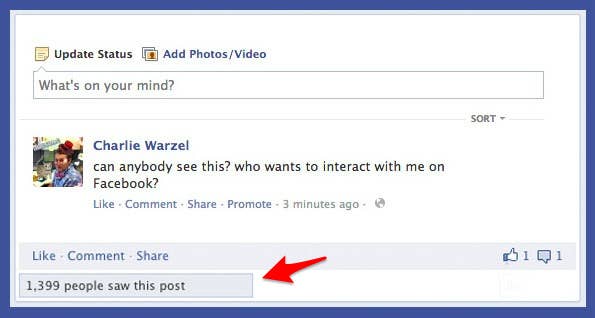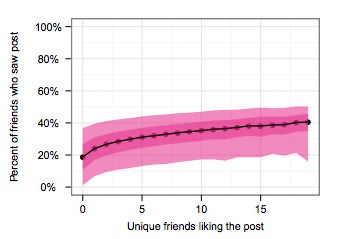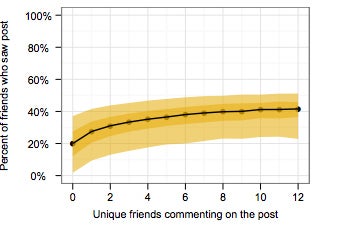
For all our obsession with "likes," comments, retweets, and reblogs — and all the careful attention to crafting our profiles — at the end of the day, the biggest question remains a mystery: How many people actually saw what you're sharing?
Sure, there are indicators. "Likes," comments, and shares are the currency of social media and offer positive reinforcement to let you know if a post has resonated with others (and to keep you coming back for more). The only problem with this feedback, according to a new study, is that it doesn't tell the whole story — in fact, it tells very little of it. "When you post on a social network, it's almost like trying to give a presentation from behind a curtain. You know who's invited and supposed to be listening, but you don't know who is actually there in the room," Stanford assistant professor Michael S. Bernstein told BuzzFeed.
In fact, most of what happens after an update is sent out takes place out of sight — only Facebook knows the truth. And it's in the company's best interest to keep that information to itself. The company knows full well that the only thing worse than speaking to an empty room is speaking to a room full of friends and family and having them ignore you.
According to a Stanford University study Bernstein conducted in tandem with Facebook's data science team, which looked at 220,000 users over the course of a month, Facebook users drastically underestimate the size of their general audience by a factor of three, with "Facebook users reaching 35% of their friends with each post and 61% of their friends over the course of a month."
For a lot of Facebook users, who are accustomed to seeing only light feedback from Facebook shares and links, this number probably sounds high. But if accurate, information like this is a rare peek under Facebook's kimono, raising this question: If so many people are "seeing" our posts on Facebook, why aren't more interacting with them?


Though roughly 21% of Facebook users surveyed cited "likes" and comments as the primary indicator of their perceived audience size, the Stanford study notes, "while users may be disappointed in posts that receive no feedback, the lack of feedback says little about the number of people it has reached."
So why are users so quick to underestimate the size of their audience? One major reason may be that they're simply afraid to discover the truth. Take these two passages from the Stanford study:
Why do people underestimate their audience size in social media? One possible explanation is that, in order to reduce cognitive dissonance, users may lower their estimates for posts that receive few likes or comments. It might be more comfortable to believe that nobody saw it than to believe that many saw it but nobody liked it.And
Some measure of social translucence and plausible deniability seems helpful: audience members might not want to admit they saw each piece of content, and sharers might be disappointed to know that many people saw the post but nobody commented or "Liked" it.
Again: It's in the interest of services like Facebook, Instagram, and Twitter to protect you from the very real possibility that your "friends" are out there and they can see what you're doing, but they just don't care. Or, alternatively, that you're less interesting than you think you are.
"I think this is something we need to better understand," Bernstein said, arguing that fear of rejection is just one of many possible reasons we underestimate our audience. "When I post content, do people not react to it but enjoy it? Do they not react to it and it is grating on them over time and they choose to unsubscribe? We don't know."
Feedback is crucial for the system to work, and networks that provide the sensation of posting into the void are quickly discarded. This, in part, is why instant messaging in all its forms is perpetually popular. It's why services like iMessage tell you your text has been "delivered" and why Gchat lets you know your friend is "typing," and it's the driving force behind the popularity of newer services like Snapchat, which thrive off of quick feedback from small audiences. As those services grow, their ability to stimulate may make large-audience, broadcast-centric networks feel dull in comparison.
There is, of course, one group privy to a glance behind the curtain. Facebook advertisers and group administrators can see post stats, including how many people "saw this post" — the key hidden metric. But revealing audience size, however large or small, is crucial to get potential advertisers to spend money, and Facebook doesn't have to worry about potential advertisers feeling ashamed. It's not personal, just business. The advertisers are the ones buying, Facebook is the one selling, and we're just the goods.
When it comes to complex, data-rich systems like Facebook, we see only a sliver of the full picture. It's not the whole story, just the part we need.
